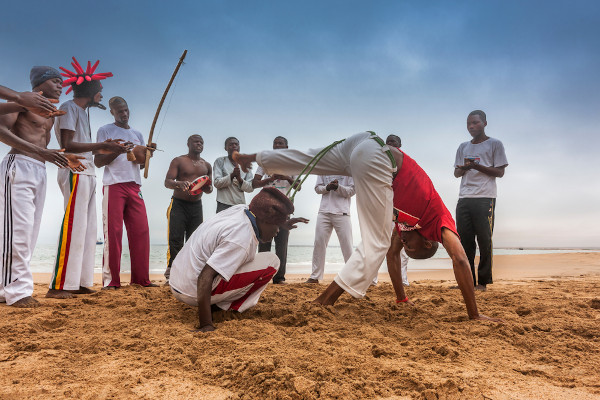Stepping onto the international stage as an embodiment of Brazilian culture, the art form of Capoeira reflects a rich and tumultuous history. From its roots in African resistance to its current status as a globally recognized practice, Capoeira transcends the definition of a mere martial art. This piece delves into the intriguing journey of Capoeira, celebrating the resilience and creativity of a community striving to preserve its identity.
Born in the crucible of slavery, Capoeira served as a clandestine form of self-defense and rebellion. It was a beacon of hope and resistance, shrouded in the guise of dance and music to fool oppressors. This history, often hidden under the surface of its rhythmic movements, is explored and elucidated in the ensuing sections.
Capoeira’s transition into a celebrated symbol of national identity did not happen overnight. It survived brutal suppression, criminalization, and cultural prejudices. This transformation from being a symbol of defiance to becoming an emblem of cultural pride reveals the intricate dynamics of Brazilian society and its complex relationship with its African roots.
Not only does this piece shed light on the historical and sociopolitical aspects of Capoeira, but it also delves into its philosophical and cultural dimensions. Understanding Capoeira as a holistic practice – a fusion of martial arts, music, dance, and philosophy – unveils a broader narrative about Brazilian culture and identity.
In conclusion, the journey of Capoeira encapsulates the resilience and spirit of a community that transformed a tool of survival into a cherished tradition. It embodies the echoes of a turbulent past while dancing to the beats of hope and cultural pride. Join us as we unravel the captivating narrative of Capoeira: from resistance to a cultural tradition.

The Historical Emergence of Capoeira
From a technical perspective, the creation of capoeira has its roots deeply embedded in the history of Brazil. Historically, it started as a form of resistance by African slaves against their Portuguese masters during the colonial period in the 16th century. The African slaves devised a unique form of self-defense disguised as a dance, thus giving birth to capoeira. This unique form of martial art was not only a means of self-defense but also a tool of rebellion and resistance.
The Evolution of Capoeira Techniques
As time progressed, capoeira began to evolve. The initial form of capoeira was more aggressive and combat-oriented, which was reflective of the harsh conditions and the spirit of resistance among the slaves. However, as slavery was abolished and capoeira began to be practiced more widely, it started to incorporate other elements. This includes a range of movements from acrobatics to dance and music, thereby becoming more of a cultural expression than a combative form.
Capoeira: A Cultural Heritage
After the abolition of slavery, capoeira continued to be practiced, but it was outlawed by the Brazilian government due to its association with African culture and its potential for violence. However, in the 1930s, capoeira was recognized by the government as a national sport and cultural heritage. Since then, it has become a symbol of Brazilian culture and identity, celebrated for its uniqueness and versatility.
Elements of Capoeira
Capoeira is a multi-faceted practice that combines elements of dance, martial arts, music, and acrobatics. Below are some of the main elements of capoeira:
- Music: Music is a crucial part of capoeira. The rhythms played on the berimbau, a one-stringed musical instrument, dictate the style of capoeira being played.
- Dance: Capoeira is often referred to as a dance-fight because of the dance-like movements that capoeiristas use in their games.
- Martial Arts: The fighting aspects of capoeira include a wide array of kicks, sweeps, and acrobatic movements.
- Acrobatics: Acrobatics in capoeira are used for evasion and deception. They add an element of unpredictability to the game.

The Global Impact of Capoeira
Today, capoeira has reached far beyond the borders of Brazil. It has become a global phenomenon, practiced in many countries around the world. Capoeira schools have sprung up in major cities across the globe, teaching people of all ages and backgrounds the art of this martial dance.
The Role of Capoeira in Contemporary Society
In today’s world, capoeira plays an important role in promoting cultural diversity, physical fitness, and social integration. It serves as a bridge between different cultures, fostering mutual respect and understanding. The practice of capoeira promotes physical strength, flexibility, rhythm, and coordination, and its music and dance aspects help build a sense of community among practitioners.
Conclusion
In conclusion, Capoeira, a martial art form deeply embedded in Brazil’s history, has transcended from being a resistance tool among African slaves to a rich cultural tradition celebrated globally. It began as a discrete form of self-defense and rebellion during the 16th century, evolving over time to incorporate diverse elements such as acrobatics, dance, and music. This evolution transformed Capoeira from a combative form to a cultural expression that extends beyond Brazil’s borders. Despite its global recognition, Capoeira preserves its African roots and Brazilian tradition, signifying resilience, cultural expression, and heritage. The multi-faceted practice amalgamates dance, martial arts, music, and acrobatics, making it a vibrant cultural heritage. Its continued influence in contemporary society promotes cultural diversity, physical fitness, and social integration, making it more than just a martial art or a sport. Capoeira is a testament to human creativity and unity, demonstrating how an art form borne out of harsh conditions can evolve into a global cultural phenomenon. It truly encapsulates the spirit of Brazilian culture and identity, a symbol of its unique and versatile heritage.

